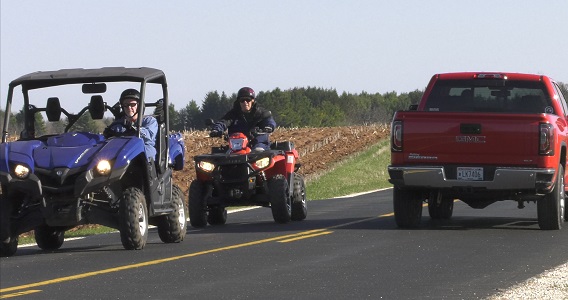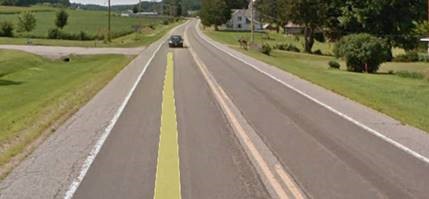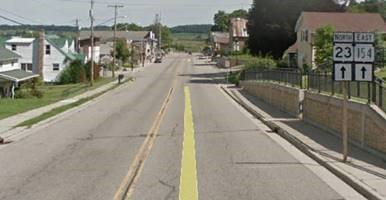Introduction

Photo courtesy of the Wisconsin ATV Association
Wis. Stat. s. 23.33 allows all-terrain vehicles (ATVs) and utility terrain vehicles (UTVs) to operate on a state highway in certain cases, which are detailed in sections A - C below. An ATV ordinance must be enacted by a municipality and/or county before operation may occur. For the remainder of this webpage, ATVs and UTVs will be labeled collectively as ATVs. Since ATVs are not allowed to operate on interstate highways, none of the information on this webpage applies to interstates.
ATV registration and ownership transfer
ATV registration and transfer of ownership is handled by the Wisconsin Department of Natural Resources (DNR) – not WisDOT. Go to the DNR's
registration website for more information.
ATV ordinances
WisDOT does not have approval authority of local government ordinances, nor can WisDOT offer information or legal advice on how ordinances should be written. WisDOT only reviews ATV ordinances prior to processing traffic signing permit applications for ATV routes to verify that a town, village, city or county has referenced the appropriate sections(s) of s. 23.33 as detailed in sections A - C below.
Consult the
Wisconsin Towns Association,
Wisconsin Counties Association, your corporation counsel, or private attorney for advice on ordinance development if needed.
ATV routes – definition
ATV routes by statute are on the roadway portion of a highway and not the shoulder or other parts of the right of way (ROW). A roadway is defined in Wis. Stat.
s. 340.01(54) as the, "portion of a highway between the regularly established curb lines or that portion which is improved, designed or ordinarily used for vehicular travel, excluding the berm or shoulder." On a 2-lane rural highway, the “roadway” is the area between the fog lines (white lines) as shown in picture (1). In an urban area, it is the area between the curbs in picture (2).
(1)

(2)

► It is important to understand that a roadway is not an ATV route until there is an enacted ordinance and the roadway is signed/posted according to law.
ATV routes on state highways
The following information is divided into three sections based on current Wisconsin statutes.
A - ATV route designation on state highways
A town, village, city or county may enact an ordinance under Wis. Stat.
s. 23.33(8)(b)1. to designate a highway not under its jurisdiction as an ATV route. In this case, ATV operation on a
state highway or
connecting highway is allowed only if WisDOT approves the route. WisDOT's approval consists of an ATV route order that is issued for the designated segment of state or connecting highway. WisDOT will review an ATV ordinance to verify that the termini of the designated route is what WisDOT and the municipality or county agreed upon prior to issuing the route order.
B - ATV operation on state highways with speed limits of 35 mph or less within municipal boundaries
A town, village or city may enact an ordinance under Wis. Stat.
s. 23.33(11)(am)4. to authorize the operation of ATVs on a highway that has a speed limit of 35 mph or less and is located within the territorial boundaries of the town, village or city regardless of who has jurisdiction over the highway. In this case, ATV operation on a state highway is not subject to WisDOT approval. WisDOT will review an ATV ordinance to verify that the statute language “authorize the operation” has been used correctly instead of the term “designated."
Much of the state highway system operates with speed limits over 35 mph, and these higher speed highways remain off-limits to ATV use without approval from WisDOT. Unless speed limits are set initially by state statutes, all speed limits in Wisconsin must be established through an engineering and traffic investigation, including further modifications that lower or raise speed limits to meet other statutory speed limits. Anyone interested in how speed limits are established is encouraged to view WisDOT’s
webpage on the topic.
Note: Under
s. 349.11(11), local authorities may post speed limits on highways under their jurisdiction that only apply to ATVs and UTVs that are lower than the speed limits imposed under s. 349.11 or
s. 346.57.
C - ATV operation on state highway bridges 1,000 feet or less in length
Under Wis. Stat.
ss. 23.33(4)(d)3.b. and
11(am)3., ATVs may be authorized to operate on the roadway or shoulder of a highway to cross a bridge 1,000 feet or less in length that is located within the territorial boundaries of a county, city, village or town, regardless of who has jurisdiction over the highway, and only if a county and a city, village or town
both enact ordinances that apply to the bridge. In this case, ATV operation on a state highway bridge is not subject to WisDOT approval.
Under the law, ATVs must exit the highway as quickly and safely as practicable after crossing the bridge. WisDOT defines this as the first available road designated as an ATV route on either side of the bridge that is not a dead end, or an ATV trail on WisDOT ROW that is established after crossing the bridge in which ATVs may use. A bridge is defined as a structure (bridge, box culvert, etc.) more than 20 feet in length over a navigable waterway, highway or railroad. See Wis. Adm. Rule
Trans 212.02(2) and
pages from WisDOT's Structure Inspection Manual.
WisDOT reviews both municipal and county ATV ordinances developed under the two bridge statutes to verify that:
- The ATV route has the appropriate termini on each side of the bridge (the first available road or ATV trail as described above) and that both ordinances mention the same roads or trails.
- All five items listed in s. 23.33(11)(am)3.(a)-(e) are also included, which is required by the statute.
- The statute language "authorize the operation" has been correctly used instead of "designated."
The term "jurisdiction" in sections A - C above refers to maintenance jurisdiction instead of the ROW (fee title) owner or highway easement owner.
ATVs using the Merrimac Ferry
WisDOT policy is to only approve small segments of the state highway system as ATV routes to assist with local ATV route continuity and when it does not adversely affect the safety, operability, mobility and maintenance of the highway. Currently, there are no continuous local ATV routes in the Town of West Point in Columbia County or the Village/Town of Merrimac in Sauk County that warrant approving state highways 113 and/or 188 in Columbia County, including the ferry, as an ATV route. Therefore, ATVs are not allowed to use the ferry.